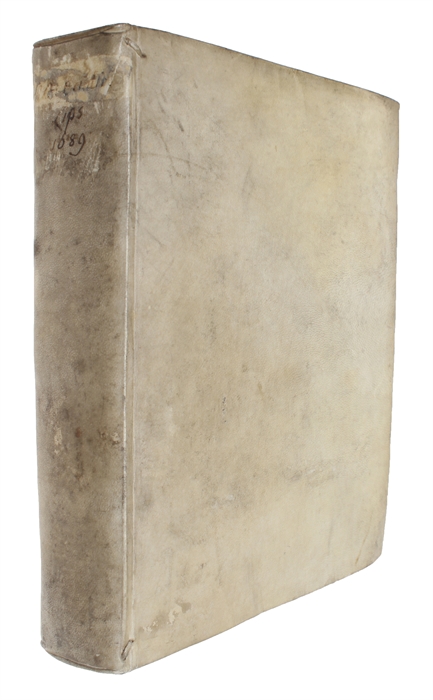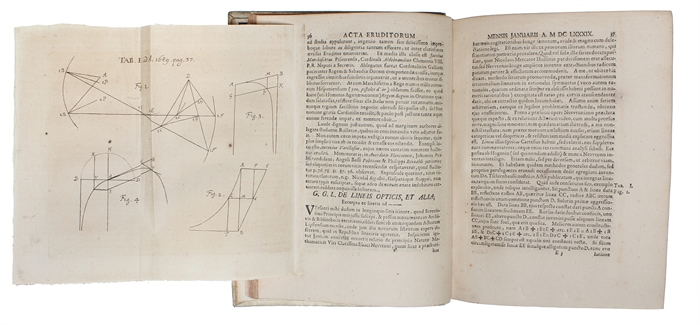THE WAR OF THE GIANTS NEWTON AND LEIBNIZ ON THE WORLD SYSTEM
LEIBNIZ (LEIBNITZ), G.F. - DENYS PAPIN - JAKOB BERNOULLI.
De Lineis Opticis, et alia; Excerpta ex literis ad--- (+) Schediasma de Resistentia Medii, & Motu projectorum gravium in medio resistente. (+) Tentamen de Motuum Coelestium causis. (+) De Linea Isochrona, in qua grave sine acceleratione descendit, & de controversia cum Dn. Abbate D.C. (4 papers by Leibniz).
Leipzig, Grosse & Gleditsch, 1689. 4to. Contemporary full vellum. Faint hand-written title to spine. A small stamp on title-page. In: "Acta Eruditorum Anno MDCLXXXIX". (8), 653, (7) pp. and 15 engraved plates. As usual with various browning to leaves and plates. The entire volume offered. Leibniz's papers: pp. 36-38 a. 1 engraved plate; pp. 38-46; pp. 82-89 a. 1 engraved plate; pp. 195-198.
First printing of these extremely important papers, in which Leibniz claimed that he independently of Newton had discovered the principal propositions of his "Principia" and which present us with Leibniz's fundamental physico-mathematical theory, his dynamics, his concepts of force, space and time.
The "Tentamen..." constitutes Leibniz's response to Newton's theories about the motion of the celestial bodies. Leibniz can be said to have anticipated the modern mathematical principle of relativity, as it is his idea of individual co-ordinate systems and his practical rejection of the Galilean co-ordinate system that Newton adopted. Leibniz opposes Newton's ideas of attractions (gravitational forces) and calls them "occult qualities". The task of the "Tentamen..." was to attain a theory mathematically equivalent to Newton's in accounting for planetary motion and especially for the inverse-square law of Kepler's laws, but physically sound and capable of explaining the causes of phenomena.
Newton attacked Leibniz's claim of priority in his anonymously published paper "Commercium epistolicum" (Phil. Transactions 1714), and states that "in those tracts the principal propositions of that book are composed in a new manner, and claimed by Mr. Leibniz as if he had found them himself before the publishing of the said book. But Mr. Leibniz cannot be a witness in his own cause. It lies upon him either to prove that he had found them before mr. Newton, or to quit his claim."
The features of Leibniz's mathematical representation of motion as put forward in "Tentamen..." are, (see D.B. Meli: Equivalence and Priority. Newton versus Leibniz. pp. 90-91):
- Empty space does not exist. The world is filled with a variety of fluids which are responsible for physical actions, including gravity.
- Living force and its conservation are the fundamental notion and principle respectively, in the investigation of nature, however, they do not figure prominently in the study of planetary motion.
- Finite and infinitesimal variables are regularly employed in the study of motion and of other physical phenomena. Living force and velocity are finite; solicitation and conatus are infinitesimal.
- Accelerated motion, whether rectilinear or curvilinear, is represented as a series of infinitesimal uniform rectilinear motions interrupted by impulses. I call this 'polygonal representation'. Usually the polygon is chosen in such a way that each side is traversed in an equal element of time dt. In polygonal representations accelerations are reduced to a macroscopic phenomenon.
- Propositions are often used to safeguard dimensional homogeneity. Constant factors - such as numerical factors, mass, and the element of time - are usually ignored in the calculations.
Denys Papin's papers:
1. Descriptio Torcularis, cujus in Actis Anni 1688 pag. 646 mentio facta a suit... and 1 plate. Pp. 96-101.
2. De Gravitatis Causa et proprietatibus Observationes. Pp. 183-188.
3. Examen Machinæ Dn. Perrault. Pp. 189-195 a. 1 plate.
4. Rotatilis Suctor et Pressor Hasciacus, in Serenissima Aula Cassellana demonstratus & detectus. Pp. 317-322 a. 1 plate.
5. In J.B. Appendicem Illam Ad Perpetuum Mobile, Actis Novemb.A. 1688 p. 592...Pp. 322-324 a. 1 plate.
6. Excerpta et Litteris Dn. Dion Papini ad --- de Instrumentis ad flammam sub aqua conservandam. Pp. 485-489 a. 1 plate.
With the paper describing and depicting Papin's famous invention of the CENTRIFUGAL PUMP. ( Rotatilis Suctor et Pressor Hasciacus, in Serenissima Aula Cassellana demonstratus & detectus. - The paper offered (no.4).
Jakob Bernoulli's papers:
1. De Invenienda Cujusque Plani Declinatione, ex unica observatione projectæ a flylo umbræ. Pp. 311-316 a. 1 plate.
2. Vera Constructio geometrica Problematum Solidorum & Hypersolidorum, per rectas lineas & circulos. Pp. 586-588 a. 1 plate.
3. Novum Theorema Pro Doctrina Sectionum Conicarum. Pp. 586-588 a. 1 engraved plate.
Order-nr.: 41661



